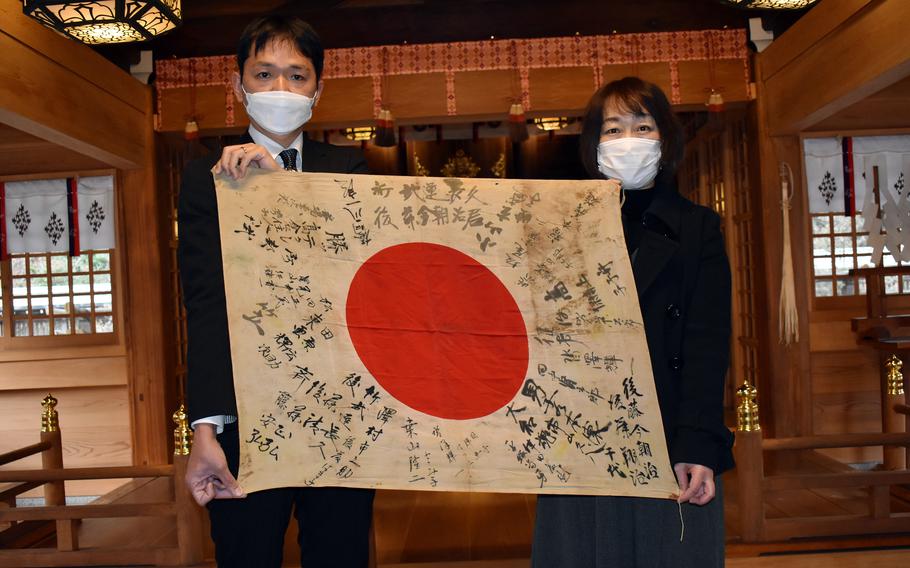
Yoshinori Goto and his wife, Miho, accept the flag of his grandfather, Japanese Imperial Army soldier Kesaji Goto, at Gokoku Shrine in Oita prefecture, Japan, Jan. 16, 2022. (Yoshinori Goto)
TOKYO — A Japanese flag, brought to America by a U.S. Navy sailor from the Battle of Okinawa, has been returned to the family of the soldier who carried it into battle more than three quarters of a century ago.
The signature-covered flag, brought home from the war by James Ellis Mercer, was returned by his daughter Linda Hahn, 72, of Concord, Calif.
Many Japanese soldiers carried the red and white flags inscribed with names and messages from family and friends for good luck.
The flag was accepted by Yoshinori Goto, 45, of Oita city, the grandson of Kesaji Goto, a Japanese Imperial Army soldier who carried the flag and died July 1, 1945, on Okinawa. The ceremony, which Hahn didn’t attend, took place Jan. 16 at the Gokoku Shrine in Oita.
Mercer, a machinist’s mate from Goodland, Kan., served aboard the seaplane tender USS Bering Strait. The warship supported aircraft that rescued dozens of downed airmen and sailors from stricken vessels during the Battle of Okinawa from April to June 1945.
The flag was folded inside an album of war photographs left by Mercer, who died in 2003 at age 83, Hahn said in a telephone interview Wednesday.
The family knew he served on Okinawa but not many other details of his wartime experience.
“He never talked about it,” Hahn said. “I don’t think it was a real happy time for him.”
After the war, Mercer set up a machine shop and worked on heavy vehicles such as forklifts and trucks, she said.
A retired bank employee and mother of one, Hahn contacted the Obon Society in September after hearing about their work from a friend. The nonprofit group helps veterans and their families return old war trophies like flags and swords.
“I thought in my heart that if the situation were reversed and it was my son who was getting something from my father, I would want that,” she said.
The society tracked down Kesaji Goto’s relatives within a couple of months. Goto was from Fujiwara village in Oita prefecture. His name is written on the flag in kanji characters.
“I am thankful that they had kept it until now and even decided to return it,” Yoshinori Goto, an employee of the Oita prefectural government, told Stars and Stripes by phone.
Kesaji Goto died in his early 30s and left behind a wife and 1-year-old son, his grandson said.
The family tomb includes an engraving of Kesaji Goto’s name. So does a monument at the Peace Memorial Park on Okinawa, Yoshinori Goto said.
The family kept a photo of their fallen relative but didn’t talk about him a lot. It was a surprise when the War-Bereaved Families Association contacted them about the flag, he said.
Some Japanese relatives of war dead, citing little or no connection with the original owners, decline to receive returned flags, but Goto had no hesitation accepting it, he said.
The news was “a bolt out of the blue,” he said. “I definitely wanted to receive it.”
The flag includes his father’s name, Shoji Goto, between his grandparents’ names.
“This shows that my father was either born or at least his name was picked when my grandfather went to war,” he said.
The flag’s return gave him a chance to talk about his grandfather with his children, he said.
“I hope people will take an opportunity to think about peace,” Yoshinori Goto said.
Although he had seen a photograph of the flag before receiving it, it felt different touching it, he said. “It tells a story,” he said. “I felt the soul of my grandfather.”